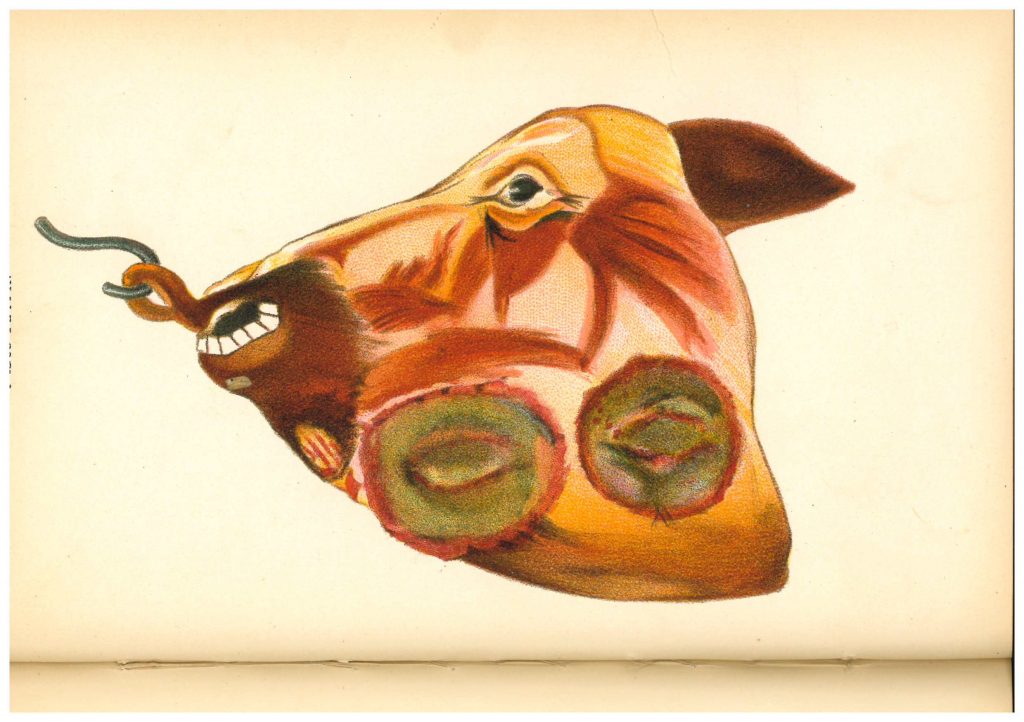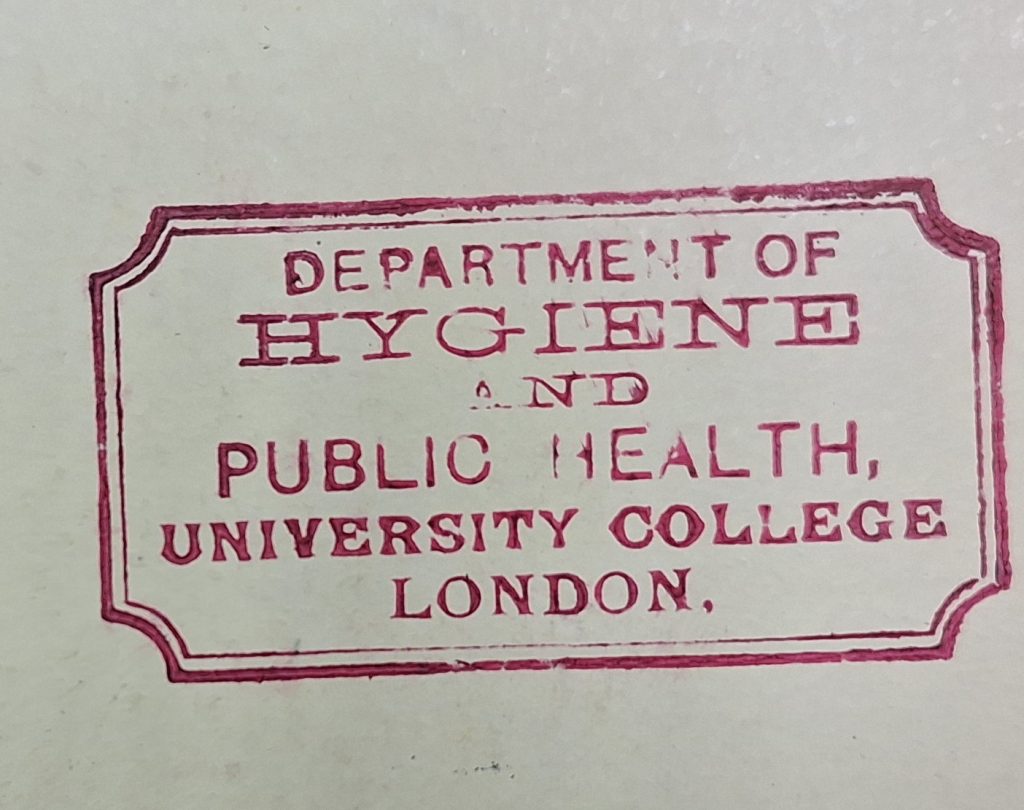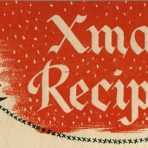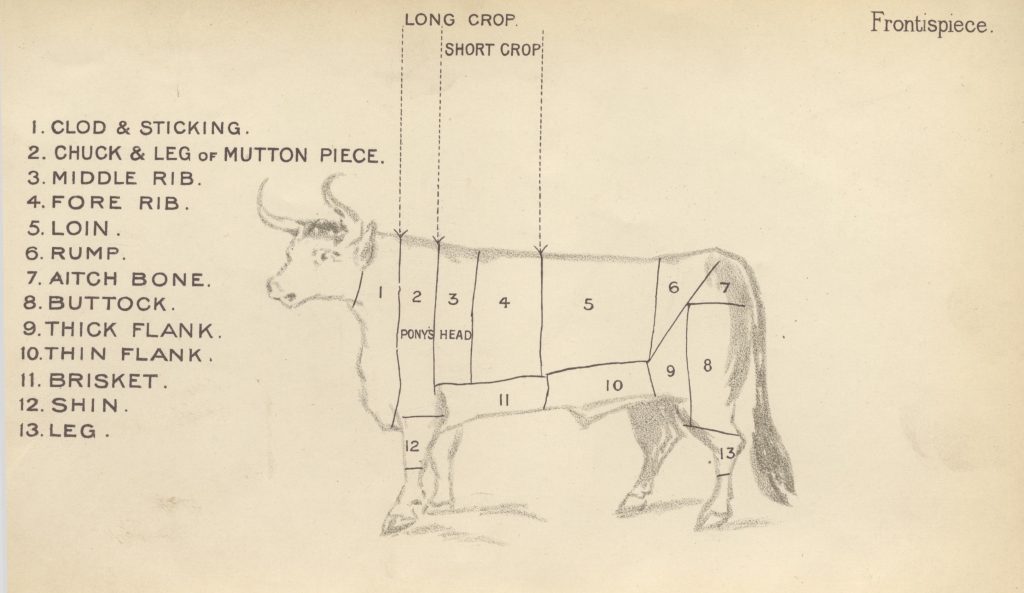This is a blog post about the book “The Inspection of Meat: A Guide and Instruction Book to Officers Supervising Contract-Meat and to All Sanitary Inspectors Embodying the Teaching Imparted to the Army Service Corps.” By W. Wylde. This item is part of the London School of Hygiene and Tropical Medicine Library’s Historical Collection. The Barnard Classification shelfmark for this item is SFM (Meat and Meat Inspection).
In the mid-19th century, meat was a staple of the Victorian diet, and the demand for it soared as London’s population swelled. However, the conditions in which animals were slaughtered and the meat was sold often left much to be desired. Slaughterhouses were commonly small, unregulated, and in densely populated areas. These facilities were typically unsanitary, with inadequate waste disposal systems leading to the contamination of water supplies and the spread of disease. The severity of these public health risks cannot be overstated, as they posed a significant threat to the well-being of the entire population (MacLachlan, 2007).
Meat markets, a hotbed of unhygienic conditions, were a time bomb for public health. Stalls, packed to the brim, exposed the meat to the elements, inviting flies and other pests. The absence of refrigeration meant that meat could spoil rapidly, posing serious health risks to the population. These conditions were not just a nuisance but a full-blown public health crisis in the making.
The dangers associated with unregulated meat markets and slaughterhouses became glaringly apparent with frequent outbreaks of diseases such as typhoid, cholera, and tuberculosis. These outbreaks were often traced back to contaminated meat and unsanitary handling practices. The public outcry grew louder as people became more aware of the direct link between these conditions and the health of their communities. (Waddington, 2007 & Metcalfe, 2016).

The call for regulation was driven by the need to ensure that meat was safe for consumption and that public health was protected. Several measures were proposed and eventually implemented to address concerns. Establishing centralised and regulated slaughterhouses outside densely populated areas crucial, these facilities were designed to adhere to sanitary standards and were equipped with proper waste disposal systems (Fitzgerald, 2010).
Legislation was introduced to mandate meat inspection by qualified health officers. This included checking the health of animals before slaughter and examining the meat post-slaughter to ensure it was disease-free. Regulations were implemented to ensure that meat markets maintained cleanliness standards.
The introduction of regulatory measures had an impact on public health in Victorian London. The standardisation and inspection of slaughterhouses and meat markets significantly reduced the incidence of foodborne illnesses (Hardy, 1999). Regulation helped instil a culture of hygiene and safety that extended beyond the meat industry to other public health and sanitation sectors.
W. Wylde and his contributions to meat inspection
W. Wylde was the chief inspector of meat for The City of London. He made a significant contribution to the field of meat inspection during this era with the 1890 publication, “The Inspection of Meat: A Guide and Instruction Book to Officers Supervising Contract-Meat and to All Sanitary Inspectors Embodying the Teaching Imparted to the Army Service Corps.” This comprehensive manual was designed as an instructional guide for officers responsible for supervising meat supplies and sanitary inspectors. Wylde’s book covered various crucial aspects, including inspection techniques, standards and regulations, handling and storage practices, and sanitary measures.
The book includes 32 chromolithographic plates. These plates were visual aids for sanitary inspectors and officers of the time, as this was before photography was common. They illustrate various aspects of meat inspection and identify signs of disease in livestock. They provided detailed images of anatomical structures and pathological conditions, helping inspectors accurately assess meat quality.

Wylde’s guide provided detailed methods for inspecting meat to detect signs of disease, spoilage, and contamination. It explained the standards for acceptable meat quality and the legal regulations that inspectors and suppliers must follow. The book also outlined best practices for handling, storing, and transporting meat to prevent contamination and ensure it remained safe for consumption. It emphasised the importance of maintaining cleanliness in slaughterhouses and markets and offered insights into the training programs for the Army Service Corps, underscoring the need for proper education for those responsible for meat inspection.

Wylde’s book is an important resource on meat inspection in late Victorian Britain. At a time when public health concerns were becoming increasingly prominent, this manual provided essential knowledge and practical advice to those tasked with ensuring the safety of meat supplies It contributed to the professionalisation of meat inspection and the establishment of higher standards in food safety, this was largely at a time when those tasked with inspecting meat markets and slaughterhouses were mostly untrained as it was largely just a part of their jobs as Sanitary Inspectors (Wylde, 1890).

The inspection of meat in Victorian London and the regulation of meat markets and slaughterhouses were crucial responses to the public health challenges of the time (MacLachlan, 2007). These measures were necessary for protecting the health of Londoners but also served as a catalyst for broader public health reforms. They form the foundation of modern food safety and public health standards. W. Wylde’s “The Inspection of Meat” is an important historical document, illustrating the early efforts to formalise and standardise meat inspection processes and reflecting the evolving practices in food safety and public health during the Victorian era.
References:
Fitzgerald, A. J. (2010) A social history of the slaughterhouse: From inception to contemporary implications. Research in Human Ecology, 17 (1), 58-69. https://www.jstor.org/stable/24707515
Hardy, A. (1999) Food, hygiene and the laboratory. A short history of food poisoning in Britain, circa 1850-1950. Social History of Medicine, 12 (2), 293-311. https://doi.org/10.1093/shm/12.2.293
MacLachlan, I. (2007) A bloody offal nuisance: the persistence of private slaughter-houses in nineteenth-century London. Urban History. Urban History, 34 (2), 227-254. https://doi.org/10.1017/S0963926807004622
Metcalfe, R. S. (2016) Meat, commerce and the city: The London food market, 1800-1855. Routledge.
Waddington, K. (2011) The Dangerous Sausage: Diet, Meat and Disease in Victorian and Edwardian Britain. The Journal of the Social History Society, 8 (1), 51-71. https://doi.org/10.2752/147800411X12858412044393
Wylde, W. (1890) The Inspection of Meat: A Guide and Instruction Book to Officers Supervising Contract-Meat and to All Sanitary Inspectors Embodying the Teaching Imparted to the Army Service Corps. Kegan Paul, Trench. Trubner & co.






